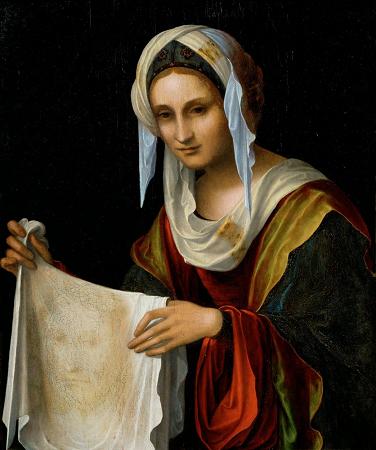Saint Veronica. Saint Veronica, also known as Berenike, was a woman of Jerusalem in the first century of the Common Era according to extra-biblical Christian sacred tradition. A celebrated saint in many pious Christian countries, the 17th-century Acta Sanctorum published by the Bollandists listed her feast under July 12, but the German Jesuit scholar Joseph Braun cited her commemoration in Festi Marianni on 13 January. According to Church tradition, Veronica was moved with sympathy when she saw Jesus carrying his cross to Golgotha and gave him her veil that he might wipe his forehead. Jesus accepted the offering, held it to his face, and then handed it back to her, the image of his face miraculously impressed upon it. This piece of cloth became known as the Veil of Veronica.The story of Veronica is celebrated in the sixth Station of the Cross in many Anglican, Catholic, Lutheran, Methodist and Western Orthodox churches. There is no reference to the story of Veronica and her veil in the canonical gospels. The closest is the miracle of the unnamed woman who was healed by touching the hem of Jesus's garment. The apocryphal Gospel of Nicodemus gives her name as Berenike or Beronike. The name Veronica is a Latinisation of this ancient Macedonian name. The story was later elaborated in the 11th century by adding that Christ gave her a portrait of himself on a cloth, with which she later cured the Emperor Tiberius. The linking of this with the bearing of the cross in the Passion only occurs around 1380, in the internationally popular book Meditations on the life of Christ. Some academic sources suggest a different origin for the legend of St. Veronica: that the cloth bearing an image of Jesus' face was known in Latin as the vera icon, and that this name for the relic was misinterpreted as the name of a saint. The Catholic Encyclopedia of 1913 writes: The belief in the existence of authentic images of Christ is connected with the old legend of King Abgar of Edessa and the apocryphal writing known as the Mors Pilati. To distinguish at Rome the oldest and best known of these images it was called the vera icon, which in the common tongue soon became Veronica. It is thus designated in several medieval texts mentioned by the Bollandists, and Matthew of Westminster speaks of the imprint of the image of the Savior which is called Veronica: Effigies Domenici vultus quae Veronica nuncupatur-effigy of the face of the Lord which is called a Veronica. By degrees, popular imagination mistook this word for the name of a person and attached thereto several legends which vary according to the country. The reference to Abgar is related to a similar legend in the Eastern Church, the Image of Edessa or Mandylion. The Encyclopedia Britannica says this about the legend: Eusebius in his Historia Ecclesiastica tells how at Caesarea Philippi lived the woman whom Christ healed of an issue of blood. Legend was not long in providing the woman of the Gospel with a name. In the West she was identified with Martha of Bethany; in the East she was called Berenike, or Beronike, the name appearing in as early a work as the Acta Pilati, the most ancient form of which goes back to the fourth century. The fanciful derivation of the name Veronica from the words Vera Icon true image dates back to the Otia Imperialia of Gervase of Tilbury, who says: Est ergo Veronica pictura Domini vera Veronica was mentioned in the reported visions of Jesus by Marie of St Peter, a Carmelite nun who lived in Tours, France and started the devotion to the Holy Face of Jesus. In 1844, Sister Marie reported that in a vision, she saw Veronica wiping away the spit and mud from the face of Jesus with her veil on the way to Calvary. She said that sacrilegious and blasphemous acts today are adding to the spit and mud that Veronica wiped away that day. According to Marie of St Peter, in her visions, Jesus told her that he desired devotion to His Holy Face in reparation for sacrilege and blasphemy. Acts of Reparation to Jesus Christ are thus compared to Veronica wiping the face of Jesus. The Devotion to the Holy Face of Jesus was eventually approved by Pope Leo XIII in 1885. Veronica is commemorated on 12 July. Saint Veronica is the patron of the French mulquiniers whose representations they celebrated biannually as in many pious Christian countries. In Volume 5 of her work, The Poem of the Man-God, Italian writer and alleged mystic Maria Valtorta depicts Veronica as Nike, who offered the linen cloth to Christ.
more...





